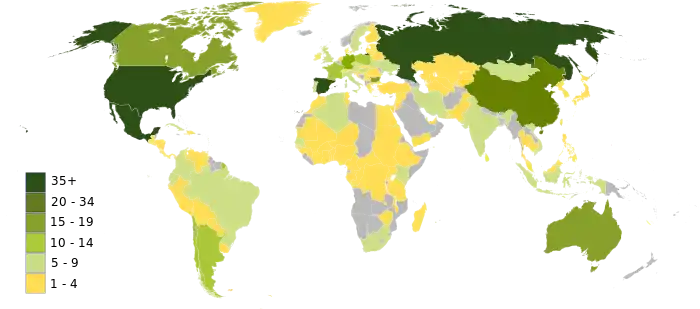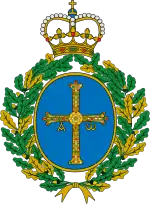World Network of Biosphere Reserves
The UNESCO World Network of Biosphere Reserves (WNBR) covers internationally designated protected areas, each known as biosphere reserves, that are meant to demonstrate a balanced relationship between people and nature (e.g. encourage sustainable development).[1][2] They are created under the Man and the Biosphere Programme (MAB).
Mission
The World Network of Biosphere Reserves (WNBR) of the MAB Programme consists of a dynamic and interactive network of sites. It works to foster the harmonious integration of people and nature for sustainable development through participatory dialogue, knowledge sharing, poverty reduction, human well-being improvements, respect for cultural values and by improving society's ability to cope with climate change. It promotes north–south and South-South collaboration and represents a unique tool for international cooperation through the exchange of experiences and know-how, capacity-building and the promotion of best practices.[2]
The network
As of 2019 total membership had reached 686 biosphere reserves in 122 countries (including 20 transboundary sites) occurring in all regions of the world.[2] Myanmar had its first biosphere reserve inscribed in 2015. This already takes into account some biosphere reserves that have been withdrawn or revised through the years, as the program's focus has shifted from simple protection of nature to areas displaying close interaction between man and environment.
| UNESCO region | Number of biosphere reserves |
Number of countries |
|---|---|---|
| African States | 79 | 28 |
| Arab States | 331 | 12 |
| Asia and the Pacific | 152 | 24 |
| Europe and North America | 292 | 37 |
| Latin America and the Caribbean | 130 | 21 |
1 Includes the Intercontinental Biosphere Reserve of the Mediterranean, shared between Morocco and Spain
* Source - UNESCO Directory of the World Network of Biosphere Reserves (WNBR), 2019[3]

Criteria and periodic review process
Article 4 of the "Statutory Framework of the World Network of Biosphere Reserves". defines the criteria for Biosphere Reserves, including
- it should encompass a mosaic of ecological systems representative of major bio geographical regions, including a graduation of human interventions
- It should be of significance for biological diversity conservation
- It should provide an opportunity to explore and demonstrate approaches to sustainable development on a regional scale
- It should have an appropriate size to fulfill the three functions of biosphere reserves (conservation, development, logistic support)
- It should include these functions through appropriate zonation, recognizing core, buffer, and outer transition zones.
Article 9 of the Statutory Framework states that “the status of each biosphere reserve should be subject to a periodic review every ten years, based on a report prepared by the concerned authority, on the basis of the criteria of Article 4".[4] If a biosphere reserve no longer satisfies the criteria contained in Article 4, it may be recommended the state concerned take measures to ensure conformity. Should a biosphere reserve still does not satisfy the criteria contained in Article 4, within a reasonable period, the area will no longer be referred to as a biosphere reserve which is part of the network.[4]
Withdrawals
Article 9 of the Statutory Framework gives a state the right to remove a biosphere reserve under its jurisdiction from the network. As of 2018, a total of 45 sites had been withdrawn from the World Network of Biosphere Reserves by 9 countries.[5] Some reserves have been withdrawn after they no longer met newer, stricter criteria for reserves, for example on zonation or area size.[6]
In June 2017, during the International Coordinating Council of the Man and the Biosphere Programme (MAB ICC) meeting in Paris, the United States has withdrawn 17 sites (out of the country's previous total of 47 sites) from the program.[7]
References
- "UNESCO Approves 13 New Biosphere Reserves for Enhanced Protection".
- "World Network of Biosphere Reserves (WNBR)". Retrieved 16 March 2019.
- "Directory of the World Network of Biosphere Reserves (WNBR)". Retrieved 16 March 2019.
- "Statutory Framework of the World Network of Biosphere Reserves".Statutory Framework of the World Network of Biosphere Reserves
- "Biosphere reserves withdrawn from the World Network of Biosphere reserves". Retrieved 16 March 2019.
- Köck, Günter; Arnberger, Arne (2017). "The Austrian Biosphere Reserves in the light of changing MAB strategies". Eco.mont (Journal on Protected Mountain Areas Research). 9 (special issue): 85–92. doi:10.1553/eco.mont-9-sis85.
- Chow, Lorraine (16 June 2017). "US Quietly Removes 17 Sites From UN Biosphere Reserve Network". Truthout. Retrieved 16 June 2017.
External links
| Wikivoyage has a travel guide for UNESCO World Network of Biosphere Reserves. |
